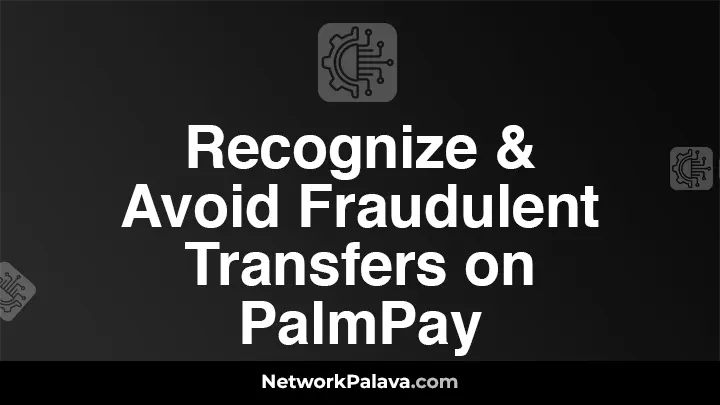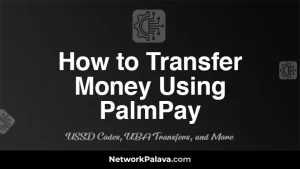Recognizing and Avoiding Fraudulent Transfers on PalmPay

At first, PalmPay was thrilling. It made payments, transfers, and shopping seamless. Everything was simple in one app. But fraud became a problem. Handling it was stressful and confusing. Over time, I discovered that spotting and avoiding scams is easy if you’re alert.
I’m not here to scare you but to give you the tools to secure your PalmPay account. Let me walk you through what I’ve learned and show you how you can protect yourself from these kinds of scams.
Recognizing and Avoiding Fraudulent Transfers on PalmPay
It’s a harsh reality that fraudulent transfers on PalmPay (or any platform) occur more frequently than one might assume. I’ve been there, and you’ve just lost everything. This underscores the need for constant vigilance.
Here is the key: perceiving the signs early and taking a brief action can be the contrast between defending your record and resources or capitulating to a stunt. The meaning of fast activity couldn’t be more noteworthy.
Understanding How Fraudulent Transfers Work
You might wonder, “How do fraudsters pull off these scams?” Well, there are a couple of common tactics they use. From phishing attacks to fake transfers and transaction reversals, fraudsters have learned how to exploit weaknesses in the system, and it’s up to you to know what to watch out for.
One of the most common scams is when someone tricks you into making a transfer under the guise of a “payment” or a “refund”. Sometimes, they’ll send you a message or an email claiming they need you to make a transfer to confirm or complete a transaction. Or, they may claim an issue with your PalmPay account and need your assistance to “verify” your details by making a small payment.
Scammers might use false screenshots or direct you to a fake PalmPay website. Their tricks can look so authentic that you may not think anything.
Recall this splendid rule: check first, pay later. Ceaselessly attest prior to making any portion. It’s a direct yet convincing strategy for making an effort not to surrender to a stunt. Prior to sending cash, reliably avow warily. It’s a model I’ve come to regard significantly. Whether it’s for a product you’re buying online, a service you’re paying for, or even a request from someone you know, always take a step back and verify the details.
For example, if someone messages you asking for money via PalmPay, don’t just act impulsively. First, ask them for more details. If you get a request from someone you know, try calling or messaging them on another app to double-check. Scammers pretend to be people you trust. It’s always best to confirm through different ways.
Watch Out for Fake Transaction Confirmations
Another scam I’ve encountered a few times involves fake transaction confirmations. Be careful, as fraudsters may contact you via email or text. Yes, claiming that the transaction has been completed on your PalmPay account. They’ll ask you to make another payment to “complete” the process or claim, and you must confirm the payment.
I’m sure you’ve seen fake confirmation messages, and they look convincing, right? But you must remember that PalmPay will never ask you to send money to confirm a transaction or verify your details. Overlook this sort of message. Click on no connections or answer.
Be Cautious of Overpayment Scams
Here’s another trick that I’ve encountered: Overpayment scams. It usually happens when someone “accidentally” sends you more money than they intended. They’ll claim it’s a mistake and ask you to refund the difference. Sounds simple enough, but here’s the kicker: Once you send them the money, they reverse the original transaction, and you end up out of pocket.
I’ve learned the hard way to always verify the amount before sending any money back to someone. Don’t send money quickly if you get a refund request like this. If you notice anything strange in your transaction history, contact PalmPay support immediately.
Fraudulent PalmPay Accounts and Impersonators
Counterfeit PalmPay accounts are a major issue. Con artists make these to bamboozle individuals and take cash. Remain alert and safeguard your assets. They could seem authentic, yet a few transfer ownership if you look carefully. For instance, con artists frequently utilize counterfeit profile pictures or names like confided in organizations, associations, or even your contacts.
One way to avoid this is to check the official PalmPay page or verify the account with the person or organization. If you get a solicitation from somebody professing to be from PalmPay or a well-known brand, ensure their account is official. Never trust just the name—check the details!
The Importance of Strong Security Practices
I’ve also learned through experience that keeping your PalmPay account secure is just as important as recognizing scams. Here are a few simple but effective security practices that can make a huge difference:
- Use a strong, unique password for your PalmPay account. Don’t use easy-to-guess passwords like “123456” or your name.
- Enable two-factor authentication (2FA). It makes your account safer, making it tough for hackers to break in.
- Monitor your transaction history regularly. Even small, unauthorized transactions can be a sign of fraud.
- Never give out your PalmPay PIN or login details. Even if someone says they’re from support, keep it to yourself.
Reporting Fraudulent Transactions Immediately
Act fast if you think someone has used your PalmPay account without permission or notice unusual activity. Contact customer support immediately. The quicker you report it, the better your chances of getting your money back and protecting your account.
PalmPay’s customer service is equipped to handle fraud cases, and they can help you take the right steps to secure your account and resolve the issue. Don’t wait around—contact them when you notice anything unusual.
How PalmPay is Fighting Fraud
PalmPay, like other monetary stages, is continually attempting to develop safety efforts and safeguard its clients. To guarantee secure exchanges, they utilize encryption and other security measures. Notwithstanding, as with any stage, keeping up with watchfulness and pursuing sound security routines remains your obligation.
The application incorporates misrepresentation cautions to warn you of possible dangers. Please give close consideration to these warnings and make a move as needed.
Considering everything, perceiving and staying away from deceitful exchanges on PalmPay is easy if you know what to search for. Con artists will constantly attempt to track down better approaches to deceive you. In any case, you can safeguard yourself and your assets by following basic advances like checking demands, avoiding counterfeit affirmations, being careful of excessive charges, and utilizing solid security rehearses.
Continuously pay attention to your gut feelings. It may be if something feels off or ridiculous. Remain informed, remain cautious, and never wonder whether or not to contact PalmPay’s client service, assuming you feel somewhat sceptical. The more you know, the more secure you’ll be while utilizing PalmPay.
Since it is now obvious how to shield yourself from misrepresentation, I believe you can continue utilizing PalmPay with certainty and genuine serenity. Remain protected out there!
How do I recognize a fraudulent transfer on PalmPay?
Fraudulent transfers on PalmPay usually exhibit certain red flags. If you notice any of these signs, it could be a fraudulent transaction:
- New Exchanges: If you didn’t start an exchange or make an installment, it’s an indication that somebody could have accessed your record.
- Bizarre Telephone Numbers or Email Locations: Fraudsters frequently utilize various numbers or email addresses for exchanges. Continuously check the subtleties of contact associated with the exchange.
- Surprising Solicitations for Installment: Be mindful of anybody requesting cash direly, particularly for administrations you didn’t ask for or know about.
- Dubious Connections: Do not click interfaces that request your PalmPay login details. They could prompt phishing locales.
Always double-check the recipient and transaction details before confirming any payment.
How would it be advisable for me to respond if I notice a fake exchange on PalmPay?
If you notice a fraudulent transfer, take immediate action to minimize the impact. You can do this:
- Contact PalmPay Backing: Report the occurrence as soon as possible. PalmPay’s client assistance will direct you through impeding the exchange and getting your record.
- Change Your Secret Phrase: Promptly update your secret phrase to major areas of strength for something unique. This forestalls further unapproved access.
- Enable Two-Factor Authentication: Activate two-factor verification (2FA) on you for an additional layer of safety.
- Record an Objection: If the objection is fundamental, document a protest with the pertinent specialists, like the police or your bank, to seek additional examination.
Act rapidly to limit the harm and safeguard your assets.
How can I avoid falling for fraudulent transfers on PalmPay?
Staying away from fake exchanges includes being careful. The following are a couple of tips to remain safe:
- Be Careful with Personal Information: Never share your PalmPay account details, PIN, or OTP with anyone, even if they claim to be from PalmPay support.
- Confirm Exchange Subtleties: Consistently check the beneficiary’s number and email or record subtleties before finishing any exchange.
- Utilize Secure Organizations: Try not to make exchanges over open Wi-Fi. Continuously utilize a solid, confidential web association.
- Check for Phishing Endeavors: Be careful about spontaneous messages, SMS, or calls requesting that you share account subtleties or make moves desperately.
- Monitor Your Account Regularly: Check your transaction history and bank balance for unauthorized activity.
Staying proactive and aware is the best defence against fraud.
How do I know if I’m dealing with a phishing attempt on PalmPay?
Phishing endeavours frequently appear as true interchanges; however, they are intended to take your data. This is the way to recognize them:
- Unusual URLs: Always check the web address in links provided in emails or texts. Fraudsters often use URLs similar to those on the official PalmPay website.
- Too Good to Be True Offers: If someone promises a huge discount or gift in exchange for your PalmPay details, it’s probably a scam.
- Urgency in Communication: Scammers often create a sense of urgency, asking you to act quickly or risk losing access to your funds.
- Unverified Email/SMS: Official communication from PalmPay will come from verified email addresses or numbers. If the sender seems suspicious, don’t respond.
If in doubt, never click on any links or provide your details. Always contact PalmPay customer support directly for verification.
What are some common scams on PalmPay that I should be aware of?
There are several scams on PalmPay that you should be cautious of:
- Fake Loan Scams: Fraudsters might offer loans or cash advances but ask for an upfront payment before disbursing funds. PalmPay does not ask for advance payments for loans.
- Prize Scams: You may receive messages claiming you’ve won a prize and need to make a small payment to claim it. These are fraudulent.
- Instalment Affirmation Tricks: Con artists might profess to be affirming instalments or exchanges, requesting that you give your record subtleties.
- Spontaneous Offers: Be careful about outsiders who contact you with offers to bring in cash through PalmPay. If you didn’t demand the proposition, it’s likely a trick.
Always trust your instincts and avoid engaging with unfamiliar offers or requests.
How can I protect my PalmPay account from fraudulent transfers?
Protecting your PalmPay account is crucial. Here’s how you can safeguard your account:
- Utilize Serious areas of strength: Pick a secret key that consolidates capitalized and lowercase letters, numbers, and exceptional characters.
- Activate Two-Factor Authentication (2FA): This adds an extra layer of security. Whether somebody takes your secret key or not, they will not be able to access your record without the second factor.
- Keep Your Phone and App Updated: Regularly update your PalmPay app and phone’s software to ensure you have the latest security patches.
- Monitor Account Activity: Watch for your record for dubious exchanges or new actions.
- Avoid Sharing Account Details: Never share your login accreditations or PIN with anybody, including PalmPay support. Official PalmPay staff won’t ever request your secret key.
Following these steps, you can protect yourself from unauthorized transfers and maintain account security.
How can I report a fraudulent transfer to PalmPay?
If you experience a false exchange, follow these moves toward reporting it:
- Contact PalmPay Client Care: Open the PalmPay application and go to the “Help” or “Backing” segment to start a report.
- Give Nitty Gritty Data: Portray the fake exchange, including the exchange ID, beneficiary subtleties, and any correspondence you received from the fraudster.
- Follow-Up: If you don’t get a timely response, follow up via email or the PalmPay social media channels for assistance.
PalmPay takes fraud reports seriously, so don’t hesitate to ask for help.
Is PalmPay responsible for fraudulent transfers?
PalmPay takes security seriously and has measures in place to prevent fraud. However, you’re also responsible for protecting your account as a user. It means you should:
- Regularly monitor your account.
- Ensure your login details are secure.
- Report fraudulent activity immediately to PalmPay.
PalmPay will investigate fraudulent transfers, but the outcome will depend on how promptly the issue is reported and the circumstances surrounding the transaction.
Can I reverse a fraudulent transfer on PalmPay?
Once a fraudulent transfer has been confirmed, PalmPay may be able to help you reverse the transaction, but it’s not guaranteed. Here’s what you should do:
- Report It Rapidly: The sooner you report a fake exchange, the higher the possibility of recuperating the assets.
- Give Proof: If conceivable, verification of the misrepresentation, for example, exchange screen captures or correspondence with the con artist.
- Adhere to PalmPay’s Directions: PalmPay will direct you through researching and possibly turning around the exchange.
Remember that PalmPay will do its best to help, but sometimes, it might be too late to reverse the transaction.
How can I recover my PalmPay account if it’s compromised due to fraud?
If your PalmPay account has been compromised, follow these steps to recover it:
- Immediately Change Your Password: Update your password to something strong and unique.
- Contact PalmPay Support: Report the breach to PalmPay customer support immediately. They will assist in securing your account.
- Enable Two-Factor Authentication (2FA): Set up 2FA for added security to prevent further unauthorized access.
- Review Recent Transactions: Check your transaction history for unauthorized payments and report them.
PalmPay will assist you in recovering your account and ensuring that it’s secure moving forward.





